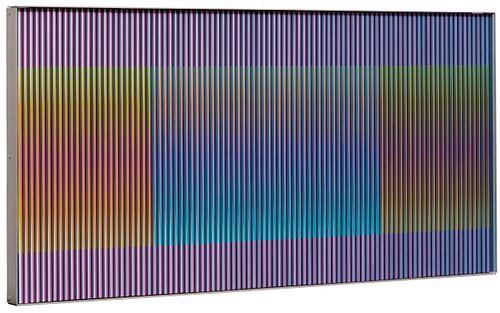CARLOS CRUZ DIEZ (Caracas, 1923 - Paris, 2019). "Physichromie, No. 1040", 1975. Acrylic and plastic elements on aluminum. Signed, dated and located
Lot 56
About Seller
Setdart Auction House
Carrer Aragó 346
Barcelona
Spain
Setdart Subastas was born in 2004 and is currently the first online art auction in Spain with solidity, prestige and reliability guaranteed by our more than 60,000 users. Setdart has a young, dynamic and enterprising team ready to successfully manage the purchase and sale of art works through custom...Read more
Categories
Estimate:
EUR€150,000 - EUR€160,000
$161,290.32 - $172,043.01
Absentee vs Live bid
Two ways to bid:
- Leave a max absentee bid and the platform will bid on your behalf up to your maximum bid during the live auction.
- Bid live during the auction and your bids will be submitted real-time to the auctioneer.
Bid Increments
| Price | Bid Increment |
|---|---|
| EUR€0 | EUR€10 |
| EUR€200 | EUR€25 |
| EUR€500 | EUR€50 |
| EUR€1,000 | EUR€100 |
| EUR€3,000 | EUR€200 |
| EUR€5,000 | EUR€500 |
| EUR€10,000 | EUR€1,000 |
| EUR€20,000 | EUR€2,000 |
| EUR€50,000 | EUR€5,000 |
About Auction
By Setdart Auction House
May 18, 2021
Set Reminder
2021-05-18 09:30:00
2021-05-18 09:30:00
America/New_York
Bidsquare
Bidsquare : Classics XIX and XX
https://www.bidsquare.com/auctions/setdart-auction-house/classics-xix-and-xx-6961
The next 18th May there will be a 19th and 20th Century Classics Auction at Setdart.com There will be a select repertoire of important artists such as Carlos Cruz Diez, Luis Feito, Joan Miró, Fernando Botero, Josep Llimona, Salvador Dalí among others. Setdart Auction House sofia@setdart.com
The next 18th May there will be a 19th and 20th Century Classics Auction at Setdart.com There will be a select repertoire of important artists such as Carlos Cruz Diez, Luis Feito, Joan Miró, Fernando Botero, Josep Llimona, Salvador Dalí among others. Setdart Auction House sofia@setdart.com
- Lot Description
CARLOS CRUZ DIEZ (Caracas, 1923 - Paris, 2019). "Physichromie, No. 1040", 1975. Acrylic and plastic elements on aluminum. Signed, dated and located (Paris), on the back. Measures: 51 x 101 cm. This work belongs to one of the artist's most relevant series, Physichromie (Physichromies). In this series he addressed the idea of chromatic autonomy, and how it could influence and modify the viewer's environment. In them we can see how he manages to transcend the role of painting, while reinventing the sculptural element, by introducing the spatial context of the viewer. This work exemplifies such theoretical work, in which the artist uses the color fields, which he combines with parallel lines, which reverse the vision of the work, depending on the place where the viewer is located. In this sense, it is important to quote the artist's words regarding the understanding of the piece: "The line is not an absolutely aesthetic element; it is an element of efficiency. I created dots or circles because the line is an essential and unadorned element, unique, to show the metamorphosis, the transformation of color. If they were curves or zigzags they would contribute nothing to the discourse of color, color as a transforming situation". The French-Venezuelan artist, Carlos Cruz-Diez, has lived and worked in Paris since 1960. He is one of the most relevant protagonists of optical and kinetic art, an artistic current that claims "the awareness of the instability of the real". His research reveals him as one of the thinkers of color in the 20th century. The plastic discourse of Carlos Cruz-Diez gravitates around the chromatic phenomenon conceived as an autonomous reality that evolves in space and time, without the help of form or support, in a continuous present. He began his artistic training in 1940, studying at the Escuela de Artes Plásticas y aplicadas, where he later became a professor. During his time as a student, he began to collaborate with publications such as La Esfera, where his comic drawings were shown. In 1944, he worked as an illustrator and graphic designer for the magazine El Farol, as well as for other publications. Two years later he became the creative director of the McCaan-Erickson advertising agency. In 1954 he began working on mural projects, in which he showed his interest in color, abstraction and geometry, which were exhibited at the XV official Salon. A year later he moved to Barcelona, visited Paris and in 1956, he exhibited his work at the Buchholz Gallery in Madrid. After traveling to New York and Paris, he returned to Caracas, where he founded the Estudio de Artes Visuales, dedicated to industrial design. A studio where he developed work that would influence his later series, such as Couleur Additive and Physichromie (Physichromia). Based on the color field current represented by Kenneth Noland and Op art. Mainly abstract current, which is based on the pictorial composition of purely optical phenomena, seeking the sensation of movement on a two-dimensional surface, deceiving the eye through complex optical illusions. Repetition structures with a clear order are used, based on rigorous scientific principles in order to produce unprecedented visual effects. In this case the principles of Op Art are put at the service of figuration, using the repetition of geometric shapes and the juxtaposition of flat colors. In 1960 he returned to Paris, definitively, and a year later he participated in the exhibition Bewogen Beweging at the Stedelijk Museum in Amsterdam where artists such as Allan Kaprow, Alexander Calder, Moholy-Nagy, Robert Rauschenberg, Jean Tinguely, Marcel Duchamp, Victor Vasarely also collaborated. In 1965 he participated in The Responsive Eye at the Museum of Modern Art in New York, an exhibition that was the official consecration of kinetic art.
- Shipping Info
-
In-House Shipping
-
- Buyer's Premium



 EUR
EUR CAD
CAD AUD
AUD GBP
GBP MXN
MXN HKD
HKD CNY
CNY MYR
MYR SEK
SEK SGD
SGD CHF
CHF THB
THB
















